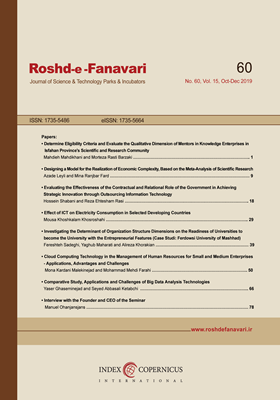Evaluating the Effectiveness of the Contractual and Relational Role of the Government in Achieving Strategic Innovation through Outsourcing Information Technology
Subject Areas : Technology Development Infrastructures and Supporting organizationshossein shabani 1 , Reza Ehteshamrasi 2
1 - Islamic Azad University
2 -
Abstract :
In this paper the effectiveness of the contractual and relational role of governmental in achieving strategic innovation through outsourcing of information technology (IT) has been studied. The main purpose of this research is to examine the quality of customer-supplier relationships and the probability of achieving strategic innovation. The research method is descriptive (non-experimental) and correlation research is a type of path analysis. The statistical population of this research is all employees of Qazvin Azad University. According to the size of the statistical population, Morgan table has been used to determine the sample size. 317 employees in Qazvin were selected as research sample. Data gathering was done through library and field surveys by standard questionnaire. The validity of the questionnaire has been used through content validity method. Cronbach's alpha coefficient was calculated for a scale of more than 0.7. The reliability of this desirable scale was evaluated by content reliabality. The results show that both hypotheses have been accepted, indicating that there is a significant relationship between the quality of customer-supplier relationship and strategic innovation with regard to the mediating role of the contractor and the relationship between the governments.
1- احمدپور، رسول. رقابتپذیري از دیدگاه مدل الماس پورتر. ماهنامه تدبیر، دروه 5، شماره 164، ص 24-19، (1388).
2- منصورآبادی، شاهد. موانع بانكداري الكترونيك در ايران. نشــريه دانــش مــديريت و حســابداري دانشکده علامه طباطبايي، دوره 4، شماره 16، ص 25-48، (1395).
3- جواب ور، سيدمحمد، حسينزاده، ماشااله. ارائه همدلي براي بررسي تأثير فناوري اطلاعات بر بهرهوري سازماني با رويكرد فرايندگرا (مطالعه در صنايع استان فارس). مـديريت فنـاوري اطلاعـات، دوره 5، شماره 4، ص 266-245، (1392).
4- Achieving step-change in outsourcing maturity: toward collaborative innovation. MIS Quarterly Executive. Vol(10), issue 3,PP. 95–109, 2011.
5- Sevin kaz, L.The Economics ofIndustrial Innovation, Pinter, London, 2007.
6- Hamel, Josephine. Foresight's Contribution Towards Co-Designed Future. Keynote presentation. The 7th Annual Conference on Foresight Management in Corporations and Public Organisations, Helsinki. 1998.
7- Koh, C., Ang, S., Straub, D.IT outsourcing success: a psychological contracts perspective. Inform. Syst. Res. Vol (15), issue 4, PP. 356–373, 2004.
8- Ellram, L.M., Tate, W.L., and Billington, C. Offshore outsourcing of professional services: A transaction cost economics perspective. Journal of Operations Management. vol. (26), issue 4 pp. 148–163, 2008.
9- Dipren, J. & Ruiqiong, Z.ITO Risks Preliminary Analysis Model of IT Outsourcing Corporations in China. School of Informatics, Guangdong University. 2004.
10- Bahli, B. & Rivard, S.Validating measures of information technology outsourcing risk factors. Omega: The International Journal of Management Science, Vol(33), issue 5, PP. 175-187, 2005.
11- Mojsilovic, A., Ray, B., Lawrence, R., Takriti, S. A logistic regression framework for information technology outsourcing lifecycle management. Computers & operation research, vol )34(, issue 6, pp. 3609-3627, 2007.
12- Riko, R. T., Boudreau, M. -C., Chen, A. J.Information systems and environmentally sustainable development: energy informatics and new directions for the IS community. MIS Quarterly. Vol (34), issue 1, PP.401-416, 2005.
13- Gavindorejan, R, terimbel, P. User acceptance of computer technology: a comparison of two theoretical models. Manage Sci. Vol (35), issue 8, PP. 982-1003, 2004.
14- Weeks, M.R., Feeny, D. Outsourcing: from cost management to innovation and business value. Calif. Manage. Rev. Vol(50), issue 4, PP. 127–146, 2008.
15- Lacity, M.C., Hirschheim, R. The information systems outsourcing Bandwagon: look before you leap. Sloan Manage. Rev. Vol (35), Issue 1 , PP.72–86, 1993.
16- Lacity, M.C., Willcocks, L.P.Business process outsourcing and dynamic innovation. Strateg. Outsour.: An Int. J. Vol (7), issue 1, PP. 66–92, 2014.
17- Aleksander, A. Is innovational ways bene, cial, Ameta-analysis of the relationship between innovation and performance in SMEs. Journal of Business Venturing.Vol (14), issue 8, PP. 212-218, 2003.
18- Tiwana, A. Systems development ambidexterity: explaining the complementary and substitutive roles of formal and informal controls. Journal of Management Information Systems. Vol (27), issue 2, PP. 87-126, 2010.
19- Goo, J., Kishore, R., Rao, H., Nam, K. The role of service level agreements in relational management of information technology outsourcing: an empirical study. MIS Quart. Vol (33), issue 1, PP. 119–145, 2009.
20- Verbeke, A; Osiyevskyy, O; A. Backman, Ch. Strategic responses to imposed innovation project: The case of carbon capture and storage in the Alberta oil sands industry. Long Range Planning, Available online 27 March. 2017.
21- Cao, J l. Mukhrejee, A. Shina, B. Firm- asymmetry and strategic outsourcing. International Review of Economics and Finance. Vol (53), iisue 8, PP. 16–24, 2018.
22- Esmaillo, Y. Masoudi Asl, I. Jamalleddin Tabibi, S. Cheraghali A. Investigating the Impact of Customer Relationship Management on the Supply Chain Based on the Mediating Role of Information Technology (Case Study: Supply of Medicine in Military Hospitals of Iran). Journal of Military Medicine. Vol (19), issue 6, PP. 579-587, 2018.
23- Preeker, Peer. De Giovanni, Pietro. Coordinating innovation projects with high tech suppliers through contracts. Research Policy. Vol (47), issue 6. PP. 1161-1172, 2018.


